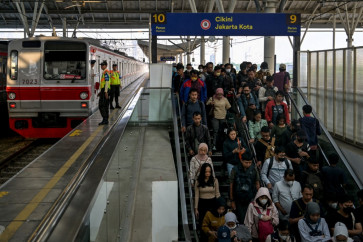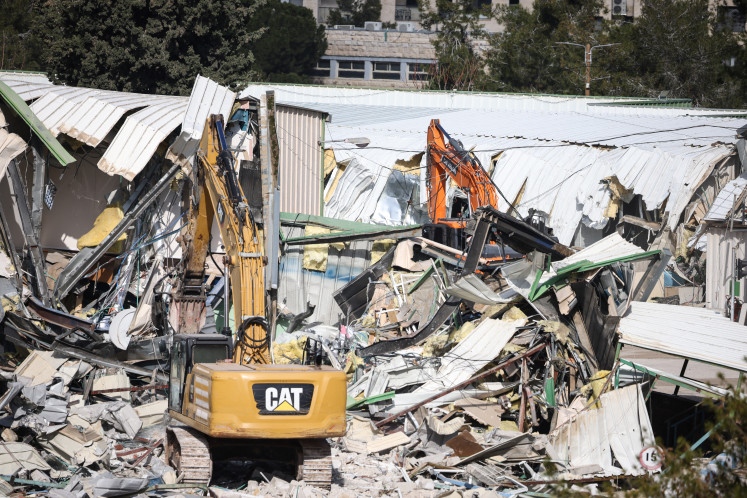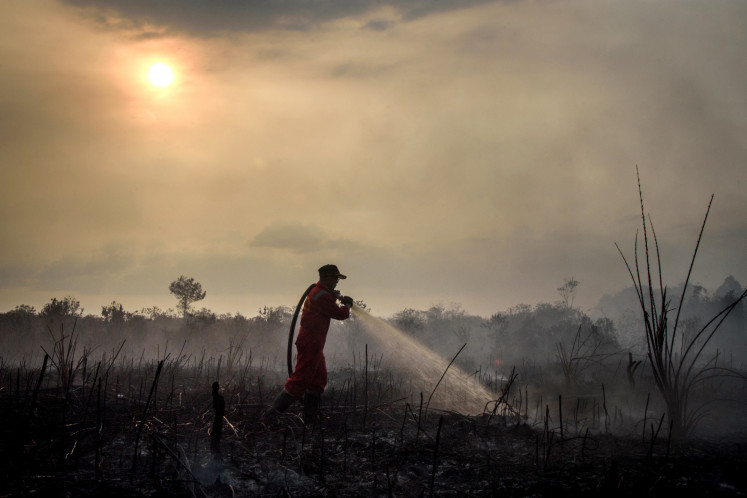Popular Reads
Top Results
Can't find what you're looking for?
View all search resultsPopular Reads
Top Results
Can't find what you're looking for?
View all search resultsSpirituality and exorcisms: A ‘bule’ view
I have never been one to believe in ghosts or possessions — maybe
Change text size
Gift Premium Articles
to Anyone
I
have never been one to believe in ghosts or possessions — maybe. As a teenage horror movie freak, I grew up on a diet including The Exorcist, The Shining and The Amityville Horror. But it was all just on the big silver screen.
Indonesia’s local horror movie industry has taken great strides since Kereta Hantu Manggarai (Manggarai Ghost Train) hit Jakarta cinemas in 2008, although there were several chillers before that. Now, just flick through the Netflix menu.
Putting aside recent blood-and-guts classics like The Night Comes for Us, Indonesian horror films are focusing on the supernatural — and exorcisms. Just watch Ruqyah: The Exorcism, Sebelum Iblis Menjemput (May the Devil Take You) and Kuntilanak. Fasten your seatbelts.
But for the average viewer, could this be part of reality? It seems that for many Indonesians I speak with, this is the case. For my maid, definitely.
Ghosts seem to exist everywhere here. Hotels are haunted — the Queen of the Southern Sea (Nyi Loro Kidul) at Pelabuhan Ratu’s Samudera Beach Hotel in Sukabumi, West Java, comes for you when you wear green, while Dutch female prisoners of war are said to haunt Surabaya’s Majapahit Hotel in East Java.
Colonial buildings are haunted — a girl who committed suicide at Semarang’s Lawang Sewu during the Japanese occupation has been seen in Central Java. Stations are haunted — various spirits stalk Jakarta’s Manggarai Station, together with the occasional ghost train, following a nearby tragic train collision in 1987 that claimed over 100 lives (the inspiration for the 2008 film).
Roads are haunted — a lady dressed in red, supposedly buried alive, has been sighted on Jl. Casablanca in South Jakarta.
Even offices are haunted. Three of the five offices I have worked in since 1999 had, I am told, spirits present, who would either appear as apparitions or “touch” staff. Bule (white people) like myself would often be a little cynical or, being more elegant, doubtful.
My maid recently planned to join her girls on a school trip to Yogyakarta. She returned early after three days. It was close to midnight. I heard much crying and wailing outside my study. My houseboy announced she was possessed by an evil spirit.
Her eyes were sunken, she could hardly walk and her usually chirpy voice was just mumbles. She was obviously confused as to where she was. I asked for her to be taken to the hospital, but I was told she needed an exorcism.
The basic concept of exorcism seems universal. Demons or other forms of spirits, causing a potential smorgasbord of physical and mental maladies, are evicted from a person or places. In Muslim exorcisms, including in Indonesia, malevolent demons and spirits known as jinn (aka genies) are weeded out as part of the Ruqyah faith.
[...] the rationale seems to be that the root of addiction is within the supernatural.
This typically involves the possessed lying down while a dukun (shaman) or sheikh — let’s call them the exorcists — places a hand on the person’s head, reciting the Quran.
Exorcisms happen in numerous religions and tribal practices. The farther one is out of urban areas, the more superstitious the population seems to be.
My maid was bundled into the car early next morning and taken to the exorcist’s house. She returned eight hours later. Yet she seemed worse. I insisted she be taken to a hospital. Yet apparently, the doctors said there was nothing they could do for her.
Next morning she was off to the exorcist’s house again. She returned after seven hours. While still shaky, she was more coherent. Three days later, she was back to her bouncy self.
Exorcisms in Indonesia, potentially fueled by the rise of Islam and the glut of movies and television shows featuring spirit disposal, are apparently increasing. Grandma’s stories no doubt also contribute. YouTube has many freaky videos. Exorcisms may be voluntary or forced by family members, or even authorities. But Indonesia is not alone.
Pope Francis has shown a renewed interest in exorcisms. The Vatican gave its seal of approval for the International Association of Exorcists in 2014 and last year the Vatican held a training course in the rites of exorcisms for priests.
Generally, there has been increased interest in the occult and exorcisms among academics, journalists and millennials. Some claim that some menacing ills, such as drugs and job lay-offs, are beyond human control — and there must be another explanation.
Beyond Islam and Christianity, exorcisms are recognized by, among others, Buddhism, Hinduism and Judaism. The rituals are different, but the concept is the same.
In Indonesia, exorcisms are not used solely for bad business decisions and afflictions such as insomnia, arthritis and asthma, however. Exorcisms have become a sub-set of “gay conversion” therapy.
A gay-exorcism may follow the style of a run-of-the-mill demonic exorcism, with one addition. Beating with a broomstick. These have been recently reported in, among other regions, Aceh and West Sumatra.
Particularly in urban areas, Indonesians tend to be at least accepting of the lesbian, gay, bisexual and transgender community. Having said this, draft changes to the Criminal Code put before the House of Representatives early last year would prohibit homosexuality and, generally, any adultery regardless of sexuality.
Meanwhile, the Indonesia Psychiatric Association continues to classify homosexuality, bisexuality and transgenderism as mental disorders.
In a similar vein, exorcisms have been used in Indonesia for the treatment of drug addiction. This would be one serious form of detox. Again, the rationale seems to be that the root of addiction is within the supernatural.
And again, Indonesia is by no means alone in the practice of addiction exorcisms. Having said this, evidence-based rehabilitation has taken great steps in recent decades.
Last week, I walked into my local gym. The gym was empty, apart from my personal trainer who was organizing some torturous exercise for me on a balance ball with barbells.
A grey-haired lady, maybe in her 70s, was impressively doing leg lifting exercises. I had never seen her before.
I asked my trainer who the woman was. He looked out, saying: “There is nobody — there has been nobody here for the last hour.” At the end of the session, we checked the reception sign-in book. I was the only person who was recorded as exercising in the past two hours.
A look of horror on the receptionist’s face: “Hantu! [Ghost!]”
For me, goosebumps. Or was I just letting my imagination run wild? I used to be indecisive about my beliefs, but now I’m not even so sure about that.
_____________________
The writer is a lawyer based in Jakarta.










